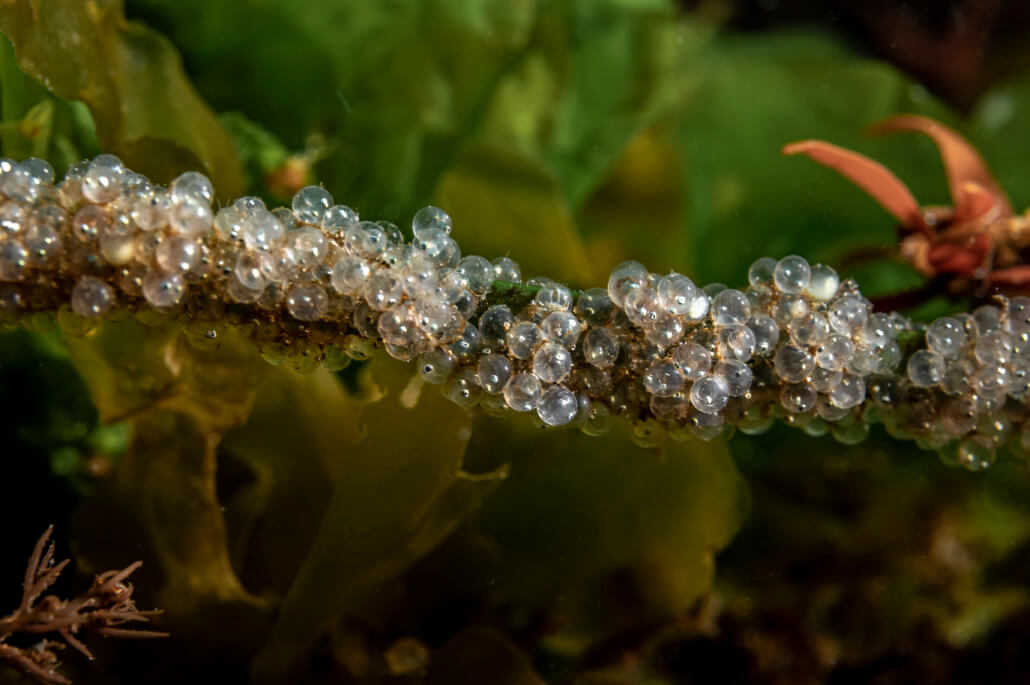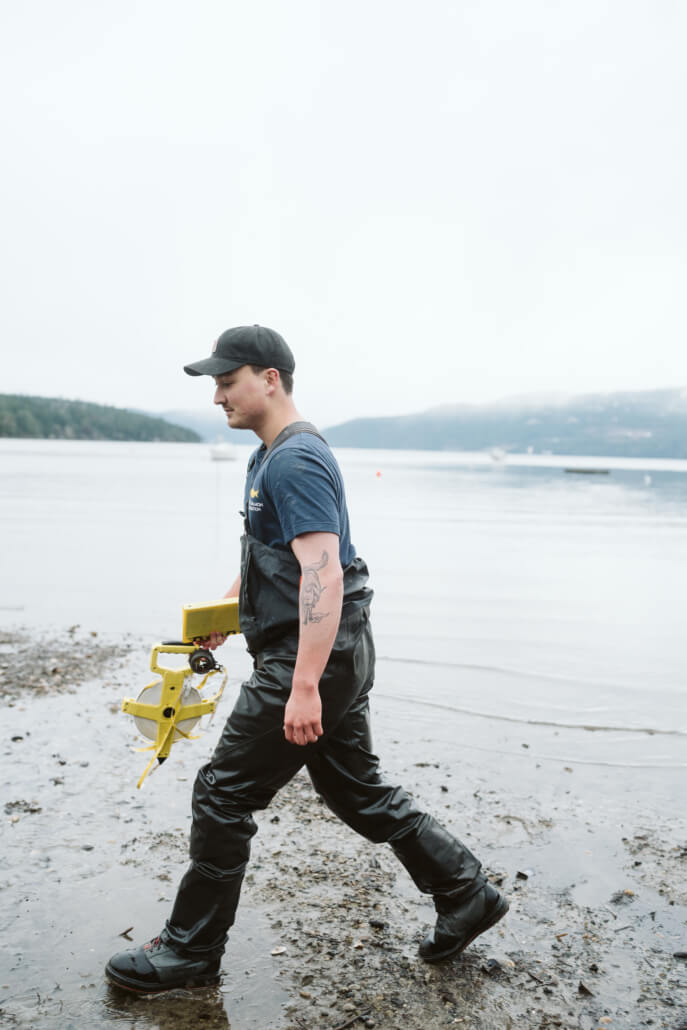Groundbreaking herring research begins in B.C.
Aug 22, 2024|inBlog, Salmon Steward
The Pacific Salmon Foundation is launching a multi-year research project to understand the role of herring in the salmon food web in partnership with First Nations communities.
This story originally appeared in the Spring 2024 edition of Salmon Steward, the Pacific Salmon Foundation’s quarterly print magazine.
Pacific salmon need herring to survive.
The small, silver forage fish – which can be found throughout the Pacific Ocean from Baja California to Japan – make up the majority of adult Chinook and coho salmon’s diet in the Strait of Georgia.
Healthy herring populations also divert seals away from targeting salmon for food.
By supplementing food supply for salmon and reducing predation pressures, there is evidence that abundant herring can boost juvenile salmon’s chances of survival.
That’s why PSF’s Marine Science Program is launching a new research project to study salmon and herring interactions, thanks to funding from the British Columbia Salmon Restoration and Innovation Fund.
“If we understand what drives long-term changes in herring abundance and distribution, and how that impacts salmon in the Strait of Georgia, we can better inform salmon conservation and rehabilitation efforts,” says Jess Qualley, project manager of PSF’s herring project.
The team will be filling in key knowledge gaps, like assessing how juvenile salmon feed on juvenile herring, tracking changes to the Strait of Georgia’s resident herring populations, and evaluating herring spawn habitat.
The multi-year project will employ innovative fieldwork methods, including satellite imagery and underwater robots to assess spawn habitat, and interpreting sound waves to estimate the size of herring populations.
Where can you see herring spawn?
The area around Denman and Hornby Island in the northern stretches of the Strait of Georgia is one of few remaining locations with consistent annual spawning events, usually peaking in March.
Another key element of the project is working with First Nations to preserve traditional ecological knowledge of herring populations.
Historically, abundant herring supported a healthy food web and were an important food source for First Nations communities in the Strait of Georgia.
But in the last century, some herring populations in B.C. waters have declined dramatically. Commercial herring fisheries began in the 1800s before continual overfishing led to a catastrophic crash in the 1960s. Many traditional spawning sites disappeared completely.
“Our name for our community is t̓išosəm – calm and milky waters from herring spawn. “Sadly, we don’t often see herring spawn in these waters anymore.” says Denise Smith, Director, Lands and Resources Department of Tla’amin Nation.
To explore the traditional cultural value of herring to coastal First Nations, PSF will provide funding for Indigenous groups to organize events and workshops that celebrate herring and bring elders and youth together. It’s an opportunity for community members to exchange knowledge about how herring has influenced the traditions, distribution, and settlement of First Nations surrounding the Strait of Georgia and inspire the next generation of marine stewards.

Pacific herring eggs laid on a frond of eelgrass in the intertidal zone. Credit: Eiko Jones
One of the communities that PSF will be partnering with is Tla’amin Nation, located on B.C.’s Sunshine Coast. Tla’amin Nation is a coastal community that depends on ocean resources for not only sustenance, but also cultural practices and teachings.
“Our name for our community is t̓išosəm – calm and milky waters from herring spawn,” says Denise Smith, Director, Lands and Resources Department of Tla’amin Nation. “Sadly, we don’t often see herring spawn in these waters anymore.”
By participating in PSF’s herring project, Tla’amin Nation hopes to be part of a collaborative process that broadens knowledge of the status of herring and explores how today’s populations continue to be impacted by contamination and climate change.
“It is our hope to be part of the exploration, restoration and rejuvenation of herring,” says Smith.
Every year between February and April, schools of herring spawn all along B.C.’s coast.
It’s a spectacular event which produces a turquoise water colour so vibrant it can be seen from space. This annual natural phenomenon provides a massive pulse of food and energy to the marine food web and attracts many species to nearshore areas including seals, sea lions, whales and, of course, salmon.
In the past, Pacific herring would spawn broadly across the Strait of Georgia, but in the last 40 years or so, scientists have seen a shift in where herring lay their eggs.
“Herring need vegetation to spawn on,” says PSF’s Jake Dingwall, who is leading habitat assessment for the herring project. “It’s an easy equation: if the vegetation is unhealthy, or missing entirely, there won’t be a successful spawn.”
It’s still the early stages of PSF’s study, but herring experts have already identified key historical and current spawn sites and will compare them to see what is potentially driving changes in spawning behaviour over time.
One of these sites is Coles Bay Regional Park, located on Pauquachin First Nation land near Victoria airport on Vancouver Island. Here, human activity has likely impacted herring’s ability to spawn.
The quiet beach that looks out into Saanich Inlet is picturesque, but concrete hardening of the shoreline has degraded important eelgrass habitat.

Jake Dingwall inspects herring habitat at Coles Bay Provincial Park in February 2024. Credit: Graham Dorsay & Brandon Deepwell
“Herring need vegetation to spawn on,” says Jake Dingwall, who is leading habitat assessment for the herring project. “It’s an easy equation: if the vegetation is unhealthy, or missing entirely, there won’t be a successful spawn.”
Dingwall is also deploying temperature loggers in intertidal zones at several sites across the Strait of Georgia, from Powell River to Denman Island.
By monitoring ocean temperature levels, in conjunction with vegetation and chemical contaminant surveys, he hopes to understand why herring spawning patterns have shifted and how that might impact salmon who feed on herring larvae.
The British Columbia Salmon Restoration and Innovation Fund is funded by the Government of Canada and the Province of British Columbia.
Learn more about the PSF’s herring project.

 CALL FOR ARTISTS! 2025-2026 SALMON CONSERVATION STAMP ART COMPETITION
CALL FOR ARTISTS! 2025-2026 SALMON CONSERVATION STAMP ART COMPETITION